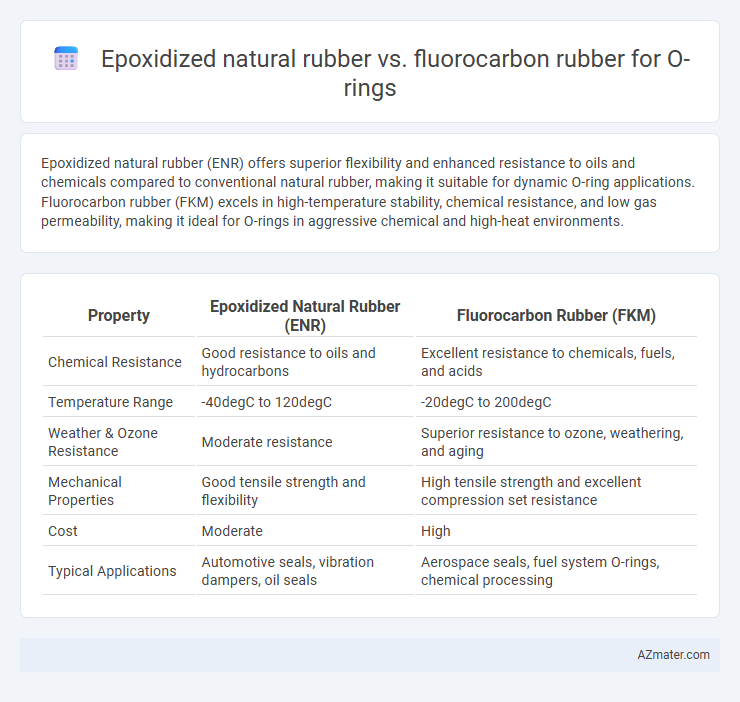Epoxidized natural rubber (ENR) offers superior flexibility and enhanced resistance to oils and chemicals compared to conventional natural rubber, making it suitable for dynamic O-ring applications. Fluorocarbon rubber (FKM) excels in high-temperature stability, chemical resistance, and low gas permeability, making it ideal for O-rings in aggressive chemical and high-heat environments.
Table of Comparison
| Property | Epoxidized Natural Rubber (ENR) | Fluorocarbon Rubber (FKM) |
|---|---|---|
| Chemical Resistance | Good resistance to oils and hydrocarbons | Excellent resistance to chemicals, fuels, and acids |
| Temperature Range | -40degC to 120degC | -20degC to 200degC |
| Weather & Ozone Resistance | Moderate resistance | Superior resistance to ozone, weathering, and aging |
| Mechanical Properties | Good tensile strength and flexibility | High tensile strength and excellent compression set resistance |
| Cost | Moderate | High |
| Typical Applications | Automotive seals, vibration dampers, oil seals | Aerospace seals, fuel system O-rings, chemical processing |
Overview of Epoxidized Natural Rubber (ENR)
Epoxidized Natural Rubber (ENR) is a modified form of natural rubber characterized by the introduction of epoxy groups into its polymer chain, enhancing its oil, heat, and ozone resistance compared to traditional natural rubber. ENR offers improved mechanical properties, including higher tensile strength and better abrasion resistance, making it suitable for O-ring applications in automotive and industrial sealing where moderate chemical resistance is needed. Its semi-polar nature allows better compatibility with polar oils and fuels, providing a cost-effective alternative to synthetic rubbers like Fluorocarbon rubber (FKM) in environments with moderate exposure.
Introduction to Fluorocarbon Rubber (FKM)
Fluorocarbon rubber (FKM) is a high-performance elastomer renowned for its exceptional resistance to heat, chemicals, and oil, making it ideal for demanding O-ring applications. Unlike epoxidized natural rubber, FKM offers superior durability in aggressive environments, maintaining sealing integrity at temperatures up to 200degC. Its unique fluorine-containing polymer structure provides outstanding resistance to fuels, solvents, and environmental degradation, significantly extending the lifespan of O-rings in automotive, aerospace, and industrial sectors.
Chemical Structure Comparison
Epoxidized natural rubber (ENR) contains oxirane groups introduced into the polyisoprene backbone, enhancing polarity and improving resistance to oils and solvents. Fluorocarbon rubber (FKM) features carbon-fluorine bonds within its polymer chain, resulting in exceptional chemical and thermal stability due to strong C-F bond energy. The key structural difference lies in ENR's epoxide rings that increase flexibility and polarity, whereas FKM's fluorinated polymer provides superior chemical inertness and protection against aggressive chemicals.
Elasticity and Mechanical Strength
Epoxidized natural rubber (ENR) offers higher elasticity due to its molecular structure, making it ideal for applications requiring flexibility and resilience in O-rings. Fluorocarbon rubber (FKM) provides superior mechanical strength and resistance to chemicals, heat, and abrasion, ensuring durability in harsh environments. While ENR excels in flexibility, FKM O-rings outperform in maintaining mechanical integrity under extreme conditions.
Temperature Resistance Performance
Epoxidized natural rubber (ENR) exhibits moderate temperature resistance, typically operating effectively between -50degC to 120degC, making it suitable for applications with mild thermal demands. Fluorocarbon rubber (FKM) offers superior temperature resilience, maintaining integrity in extreme conditions ranging from -26degC to 204degC and resisting degradation from high heat exposure. For O-ring applications requiring high-temperature performance and chemical stability, fluorocarbon rubber provides a more reliable sealing solution compared to epoxidized natural rubber.
Chemical and Oil Resistance Capabilities
Epoxidized natural rubber (ENR) offers enhanced resistance to polar solvents, oils, and chemicals due to the epoxy groups in its molecular structure, providing improved chemical stability compared to standard natural rubber. Fluorocarbon rubber (FKM) excels in resisting a wide range of aggressive chemicals, fuels, and oils, including hydrocarbons, synthetic fluids, and aromatic solvents, with superior thermal and oxidation resistance for high-performance O-ring applications. When chemical and oil resistance is critical, FKM generally outperforms ENR, especially in harsh environments involving strong fuels or high-temperature conditions.
Ozone and Weathering Resistance
Epoxidized natural rubber (ENR) offers moderate ozone and weathering resistance due to its improved polarity and cross-linking compared to natural rubber, making it suitable for dynamic O-ring applications exposed to mild atmospheric conditions. Fluorocarbon rubber (FKM) exhibits superior ozone and weathering resistance because of its highly stable carbon-fluorine bonds, which prevent degradation from UV radiation, ozone exposure, and harsh environmental elements. For O-rings requiring long-term durability in aggressive outdoor or industrial environments, FKM is the preferred elastomer, while ENR serves well in less demanding scenarios with moderate exposure.
Cost Efficiency and Availability
Epoxidized natural rubber (ENR) offers a cost-effective solution for O-rings due to its lower raw material and manufacturing expenses compared to fluorocarbon rubber (FKM), which is generally more costly because of complex synthesis processes. ENR benefits from widespread availability of natural rubber resources, ensuring consistent supply and reducing lead times, whereas FKM relies on specialized fluorochemical production with limited suppliers, impacting availability and driving up prices. Cost efficiency and supply chain stability make ENR a preferred choice for applications with moderate chemical resistance requirements, while FKM is reserved for high-performance environments despite its higher cost and limited availability.
Applications in O-Ring Sealing Systems
Epoxidized natural rubber (ENR) offers excellent flexibility and oil resistance, making it suitable for O-rings in automotive and industrial sealing systems where moderate chemical exposure occurs. Fluorocarbon rubber (FKM) provides superior chemical, heat, and ozone resistance, ideal for high-performance O-ring applications in aerospace, chemical processing, and fuel system seals. Selecting between ENR and FKM depends on specific sealing requirements, including temperature range, chemical compatibility, and longevity in harsh environments.
Selecting the Right Material: ENR vs FKM for O-Rings
Epoxidized natural rubber (ENR) offers superior flexibility, excellent wear resistance, and enhanced ozone and oil resistance, making it ideal for dynamic O-ring applications in automotive and industrial settings. Fluorocarbon rubber (FKM) excels in high-temperature stability, chemical resistance to fuels, solvents, and aggressive acids, making it the preferred choice for sealing in harsh chemical environments. Selecting between ENR and FKM depends on operational conditions such as temperature range, chemical exposure, and mechanical stress for optimal O-ring performance and durability.

Infographic: Epoxidized natural rubber vs Fluorocarbon rubber for O-ring
 azmater.com
azmater.com